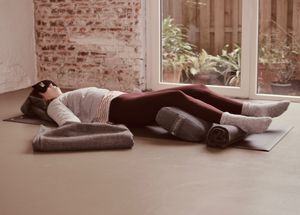“I know you can do more, but can you do less?”
These words from my Restorative Yoga teacher, Lizzie Lasater, explain so much about the essence of this practice. So many of us are focused on self-improvement through progress we can physically measure – being better, faster, stronger (thanks, Daft Punk) – that we neglect the shadow side, the side that begs for a long exhale. If an inhale represents our active practice, Restorative Yoga is the complement: a deep breath out.
For the greater part of my life, I’ve been battling a chronic health condition that a number of years ago had reached boiling point. It was then, when I could barely do a sun salutation, that I truly discovered Restorative Yoga and all its benefits. Defined as ‘the use of props to support the body in positions of ease and comfort, to facilitate relaxation and health’ (although I like to call it ‘cloud yoga’, since you really do feel like you’re lying on a cloud), Restorative Yoga is about opening, not stretching. The pose does you, rather than vice versa.
This may sound like Restorative is a practice for the impaired: for those who physically can’t do more. But the goal is to move into parasympathetic dominance, or rest-and-digest mode – something every body needs to function at its best. Sympathetic dominance – aka fight-or-flight mode – is a remnant from our cave-dwelling ancestors, who needed to stand their ground or run for cover when faced with predators. Although we still need this instinct in emergency situations, the stresses of modern life mean that many of us live with a perpetual adrenalin rush. It’s no wonder that everyone seems to know someone suffering from issues such as burn-out. In parasympathetic dominance, however, the body can work through slower processes – things like digestion and immunity. While each pose has physical benefits – helping to reduce pain, tension and fatigue; opening and stimulating specific organs; lowering blood pressure – the practice can also offer mental clarity, calmness and decreased anxiety.
So if all you’re doing is lying around on bolsters, why can’t you just sleep instead? The difference is that Restorative Yoga is conscious rest. Your mind is still awake – though moving deeper inwards – while your body is relaxed. We may rise from a night’s sleep with aches and pains, realizing we’ve been unconsciously tensing our muscles. And in Restorative, as in meditation, we can practise becoming the neutral observer of our minds, rather than letting them wander aimlessly into a dream state.
With today’s demanding schedules, it can be hard to carve out time for a practice where it seems, from the outside, like there’s not much happening. But we all need rest, and there’s so much more going on behind the scenes than what’s immediately obvious – trust me. Or better still, find out for yourself.
I first wrote the article above for the blog of The Breathing Space, the yoga studio in Amsterdam where I teach Restorative. I've just returned from London after deepening my training with grandmaster Judith Hanson Lasater herself (look her up; buy her books), and one of her many pearls of wisdom was, in fact, a prescription: 20 minutes of Restorative, 6 days a week; 60 minutes on the 7th day; and for one week of every year, make 1 hour of Restorative your sole practice. She often chooses the period between Christmas and New Year as the full Restorative special.
If you're asking, but how do I start?, then you have a few options. One is to find a class near you. See here for a list of teachers certified to teach Judith Hanson Lasater's method of Restorative. Otherwise, start with the key posture: supported savasana. No, those five minutes you might spend flat on your mat after an active practice don't count. Restorative savasana is very, very different. Luckily, the Lasaters have shared this handy video to guide you through the process. Now, if you're the type of person who has a practice more like fire than like water – you roar off the mark, only to fizzle out shortly after – I’d recommend starting slower. Try once a week for the first week, two the second, and so on. I guarantee you’ll see the benefits.
